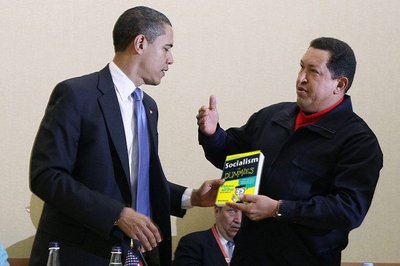by the Night Writer
Greg Marmalard: Remain calm! All is well!
D-Day: Ramming speed!
Flu pandemics have become kind of a hobby of mine, not out of morbid interest but because I work in an industry that has to anticipate and model the potential impact of such things and also because I’m part of the team at work responsible for coordinating and communicating responses to a campus-wide disruptions such as fire, earthquake, tornados … or large numbers of employees unable to come to work. As such we get information from groups such as the World Health Organization and from Risk Management Solutions (RMS), a company that does catastrophic risk modeling.
The information that I am receiving from these very credible sources suggests, coupled with what I know of the avian-flu scare, that there is some reason to be concerned but no reason to lose perspective. I’ll share the bad news and good news here, along with a hat-tip to a previous Presidential administration likely to go unmentioned in the media accounts.
First some general information that will help the perspective. Pandemics are inevitable. Historically, the world gets one roughly every 30 years. the 1957 Asian Flu (which knocked my mother down while she was pregnant with me) and the 1968 Hong Kong Flu were fairly close together but it’s been 40 years since then so we’re “due” in actuarial terms. Advances in healthcare, prevention, sanitation, etc. have little to do with preventing an outbreak, though they do help mitigate its effects. The ’57 and ’68 pandemics “only” killed 2 to 8 million people globally….compared to grand-daddy of all flus, the so-called Spanish Flu of 1918 which killed an estimated 20 to 40 million, including (conservatively) 600,000 in the U.S. The latter pandemics were “milder” not because of better overall health, however, but because they were different strains that attacked in different ways from the Spanish Flu — a strain identified as H5N1, the same as the bird flu we heard so much about a few years ago. The reason that the Avian Flu, which killed 50 percent of those infected, hasn’t spread is because it hasn’t mutated into a form communicable human-to-human (those who died received the flu directly from handling poultry).
All flu viruses — whether our annual garden-variety flu strains or the most deadly ones — arise from animals (like birds or pigs); the virus mutates (called antigenetic drift) as it comes into contact with other organisms and spreads by becoming more communicable each time. I don’t know how many of these strains never develop to where they can be communicable between humans, but I do know that at least one crosses that evolutionary finish line every year. Generally these are comparatively mild but the potential is always there for a nasty strain. Indications are that this current version (identified as an A/H1N1), while called a Swine Flu, is actually a combo platter of Swine and Avian Flus and of strains already found in humans — this makes it more communicable, but also means we’re likelier to have more natural resistance.
Good news:
A/H1N1 is not H5N1, nor has it reached pandemic status yet. While people are dying from this (none so far in the U.S.) the early projections, hampered as they are by limited data so far, suggest that if it becomes a pandemic it will a moderate one with a chance to become severe. As RMS notes:
A typical ratio of actual cases to those hospitalized is likely to be between 2 to 10. This would give a case load estimate of between 3,000 and 16,000 people infected, and would suggest that the virus virulence is between 3.4% and 0.6% Death per Case. As context, the 1918 pandemic had a Death per Case of 2.5%, so when case loads are properly counted this virus could turn out to be as virulent or worse than the 1918, but it is more likely to be of significantly lower virulence. It seems to be considerably more deadly than normal seasonal flu, which has a DpC of around 0.1% but evidently does not have a virulence anywhere near as severe as the H5N1 ‘avian flu’ virus in the outbreak of 2006-07, which had a DpC of over 50%. In general this is likely to be classed as a ‘Low Pathogenicity’ influenza virus.
Another positive, according to Tevi Troy in a commentary in today’s Wall Street Journal, is that concerns about an Avian Flu outbreak as early as 2004 has led to better preparedness today:
Under President Bush, the federal government worked with manufacturers to accelerate vaccine development, stockpiled crucial antivirals like Tamiflu, war-gamed pandemic scenarios with senior officials, and increased the Centers for Disease Control and Prevention’s (CDC) sample identification capabilities. These activities are bearing fruit today.
The Department of Health and Human Services (HHS) has already deployed 12.5 million courses of antivirals — out of a total of 50 million — to states and local agencies. In addition, CDC’s new capacities have allowed Mexican officials to send flu samples to CDC for quick identification, a capability that did not exist a few years ago. Collaboration between the government and the private sector on vaccines — which Mr. Bush and his HHS team actively encouraged — could potentially allow manufacturers to shepherd a vaccine to market within four months of identifying the strain and getting the go-ahead from CDC or the World Health Organization.
…
Another issue: Under the Public Readiness and Emergency Preparedness (PREP) Act of 2006, the government has the authority to issue “Prep Act Declarations” granting liability protection to manufacturers whose products were used in public-health emergencies. This helps encourage manufacturers to develop countermeasures. The government issued a series of such declarations in 2007 and 2008. They protected the development and use of influenza vaccines and pandemic antivirals, as well as anthrax, smallpox and botulism products. The Obama administration should consider granting more of them — if appropriate — in the weeks ahead.
So far it also appears that this strain responds to Tamiflu — there had been concerns that the next significant flu mutation might be resistant.
It’s also worth noting that early indications are that the Initial Virus Reproductive Number (RO) of this outbreak appears to be low, meaning that the number of people infected by the virus by exposure to someone who has it is containable. While they are still tracing the infectiousness of the cases in Mexico, it is so far thought to be below the 1.5 RO of the typical seasonal flu. While the public’s awareness of this flu has increased dramatically in the past few days, reports of the outbreak have been coming in for weeks, suggesting it is containable.
An RO exceeding 1.8, however, is considered “uncontainable”; the RO of the 1918 pandemic was 2.7, while 1957’s was 2.1 and 1968’s was 2.0.
Bad news
It’s too early to judge if there’s really bad news yet, but most of the deaths so far have been in the young to middle-aged adult population. This is a concern because this is typically the healthiest and most-resistant group to influenza — and also the group that had the highest mortality in the 1918 outbreak. While infants and the aged typically account for most flu deaths each year, a return of the Avian Flu could turn this expectation on its head. Part of the theory is that this group is less likely to take the initial onset of the attack seriously and simply try to work through it (even bringing it to work with them). By the time they realize they’re truly sick they may be irreversibly caught in the spiral of a cytokine storm where the body’s own immune system becomes over-stimulated and actually attacks itself, with death occuring in as little as 48 to 72 hours. If this reaction is part of the viral bundle now being handed out it could get ugly. So far, however, pathology of deaths from this flu are being described as “severe pneumonia” (a common cause of death initiated by the flu) and not indicative of a cytokine storm. This is something that is going to be watched closely, however, as things progress.
Also at risk, of course, is the economy — you know, the one that’s been so hale and hearty of late. If you recall the effect of the SARS outbreak a few years ago on the Toronto economy — airports and businesses shut-down, people afraid to leave their homes — the same thing could happen on a larger scale if this progresses. Currently the WHO is studying whether it should raise the pandemic alert from level 3 to level 4 or 5, which would trigger national pandemic response plans that include travel restrictions, border closures, prohibitions on public gatherings (such as sporting events) and would issue drugs to front-line health responders.
The US has declared a Public Health Emergency – one step below the implementation of its full pandemic response plan. Many other countries are likely to ramp up their response measures soon.
More information is available on-line from the World Health Organization and the Centers for Disease Control. You can also review the series of posts I did on Avian Flu a few years back as these are still relevant. As I wrote then: by all means, come to your own conclusions. At the least I think you’ll find this subject is food for thought – and prayer.
Update:
The WHO has raised the Pandemic Alert to Phase 5 (evidence of of significant human-to-human transmission). Phase 6 is the highest alert and describes a pandemic situation (featuring “efficient and sustained widespread human-to-human transmission).
















